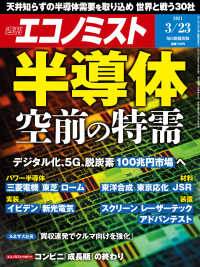- ホーム
- > 洋書
- > ドイツ書
- > Social Sciences, Jurisprudence & Economy
- > Politics, Society, Work
- > general surveys & lexicons
基本説明
Gives a new and integrated introduction to item response models (predominantly used in measurement applications in psychology, education, and other social science areas) from the viewpoint of the statistical theory of generalized linear and nonlinear mixed models.
Full Description
This edited volume gives a new and integrated introduction to item re sponse models (predominantly used in measurement applications in psy chology, education, and other social science areas) from the viewpoint of the statistical theory of generalized linear and nonlinear mixed models.
-

- 電子書籍
- 私がひとりで生きてくなんて(2)
-

- 電子書籍
- 【分冊版】帰郷 1 MeDu COMI…
-

- 電子書籍
- むずかしい女性が変えてきた――あたらし…
-

- 和書
- 悪魔学大全 (新版)
-

- 電子書籍
- 週刊エコノミスト2021年3/23号



